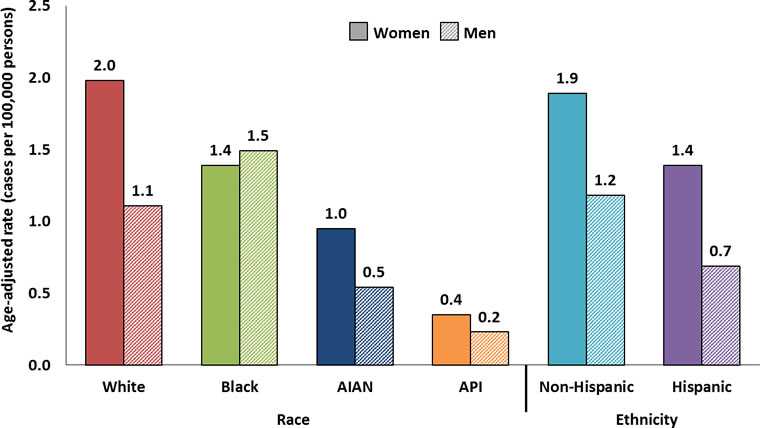HPV-Associated Anal Cancer Rates by Race and Ethnicity
It is estimated that about 3,400 new cases of HPV-associated anal cancers are diagnosed in women and about 1,800 are diagnosed in men each year in the United States.* More white women get HPV-associated anal cancer than women of other races. More black men get HPV-associated anal cancer than men of other races.
*Note: This study used cancer registry data to estimate the amount of HPV-associated cancer in the United States by examining cancer in parts of the body and cancer cell types that are more likely to be caused by HPV. Cancer registries do not collect data on the presence or absence of HPV in cancer tissue at the time of diagnosis. In general, HPV is thought to be responsible for about 91% of anal cancers.
HPV-Associated Anal Cancer Rates by Race, Ethnicity, and Sex, United States, 2009–2013

The graph above shows the age-adjusted incidence rates for HPV-associated anal cancer in the United States during 2009–2013. “AI/AN” means American Indian/Alaska Native, and “A/PI” means Asian/Pacific Islander. The rates shown are the number of men or women who were diagnosed with HPV-associated anal cancer for every 100,000 men or women.
- Among whites, about 2.0 women and 1.1 men per 100,000 were diagnosed with HPV-associated anal cancer.
- Among blacks, about 1.4 women and 1.5 men per 100,000 were diagnosed with HPV-associated anal cancer.
- Among American Indian/Alaska Natives, about 1.0 women and 0.5 men per 100,000 were diagnosed with HPV-associated anal cancer.
- Among Asian/Pacific Islanders, about 0.4 women and 0.2 men per 100,000 were diagnosed with HPV-associated anal cancer.
- Among Hispanics, about 1.4 women and 0.7 men per 100,000 were diagnosed with HPV-associated anal cancer.
- Among non-Hispanics, about 1.9 women and 1.2 men per 100,000 were diagnosed with HPV-associated anal cancer.
Data are from population-based cancer registries participating in the CDC National Program of Cancer Registries and/or the NCI Surveillance, Epidemiology, and End Results Program, meeting criteria for high data quality for all years 2009–2013, and covering about 99% of the U.S. population.
Reference
Viens LJ, Henley SJ, Watson M, Markowitz LE, Thomas CC, Thompson TD, Razzaghi H, Saraiya M, Centers for Disease Control and Prevention (CDC). Human papillomavirus–associated cancers—United States, 2008–2012. MMWR 2016;65(26):661–666.
- Page last reviewed: March 3, 2017
- Page last updated: March 3, 2017
- Content source:


 ShareCompartir
ShareCompartir